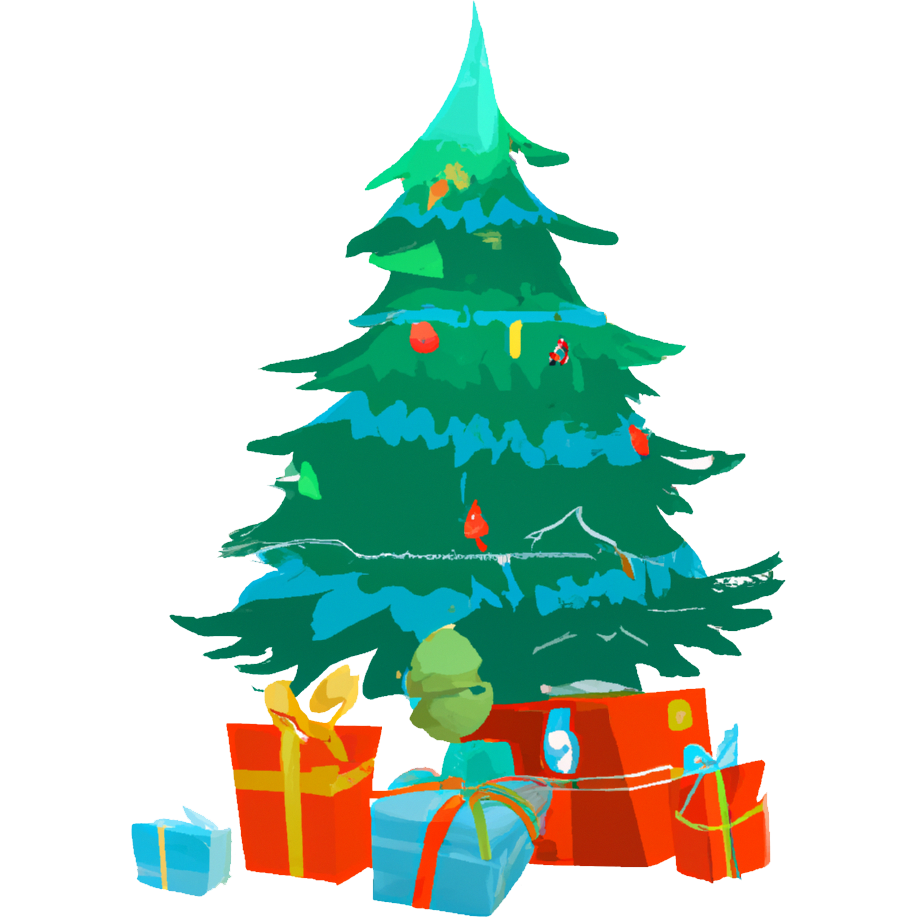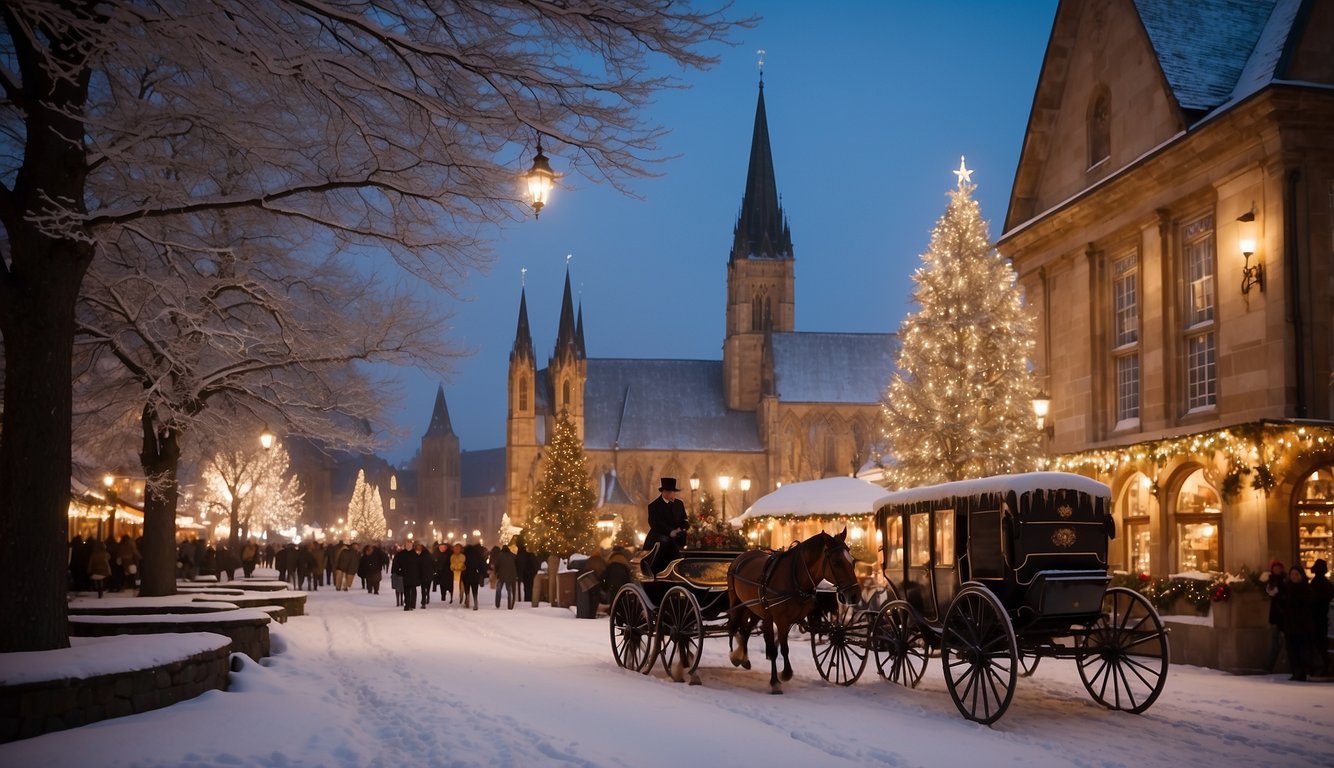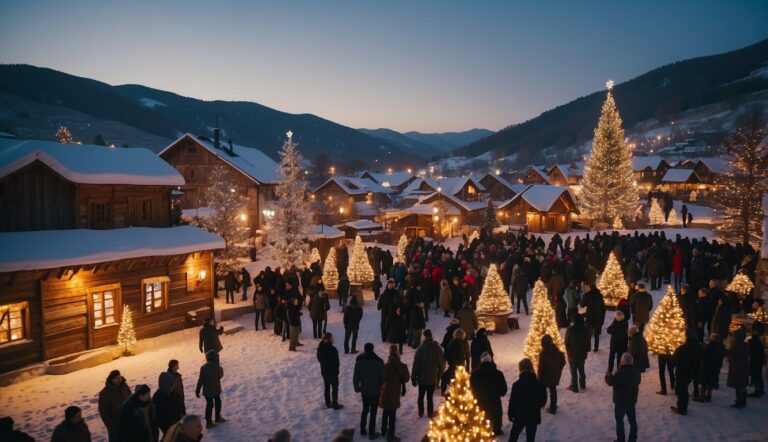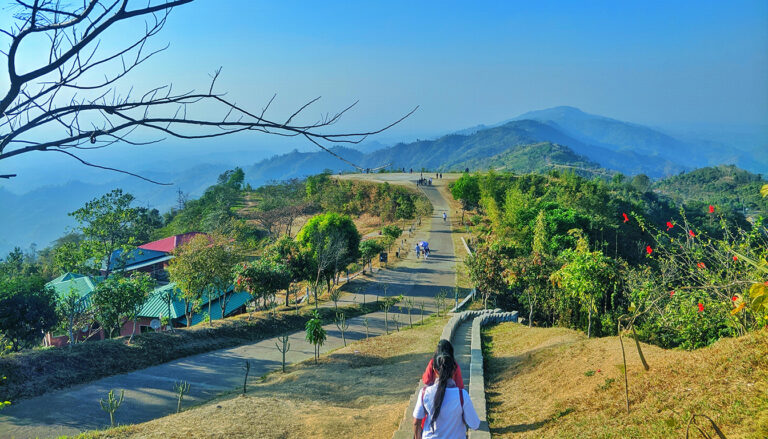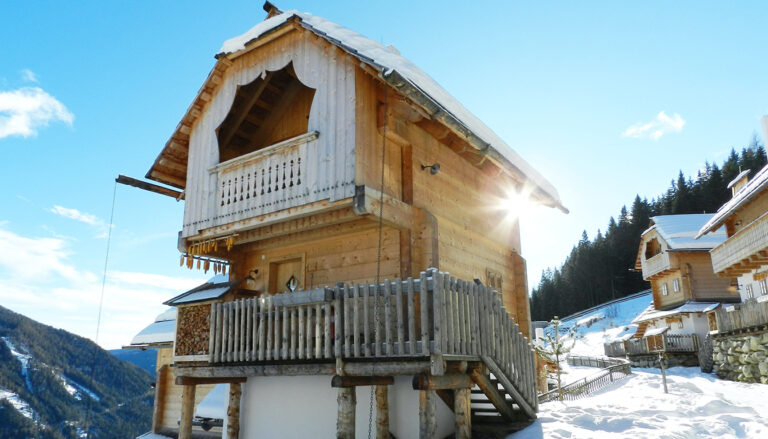Discovering Christmas Traditions in Belgium: A Festive Guide
Christmas in Belgium presents a captivating blend of traditions, where the cultural influences of neighbouring Germany, France, and the Netherlands come together in festive harmony. During the holiday season, Belgium transforms into a winter wonderland with charming Christmas markets, sparkling lights, and an air of celebration permeating the cities from Brussels to Antwerp. The Belgian Christmas, deeply rooted in religious and secular customs, offers a warm, communal spirit that draws locals and tourists into its delightful yuletide embrace.
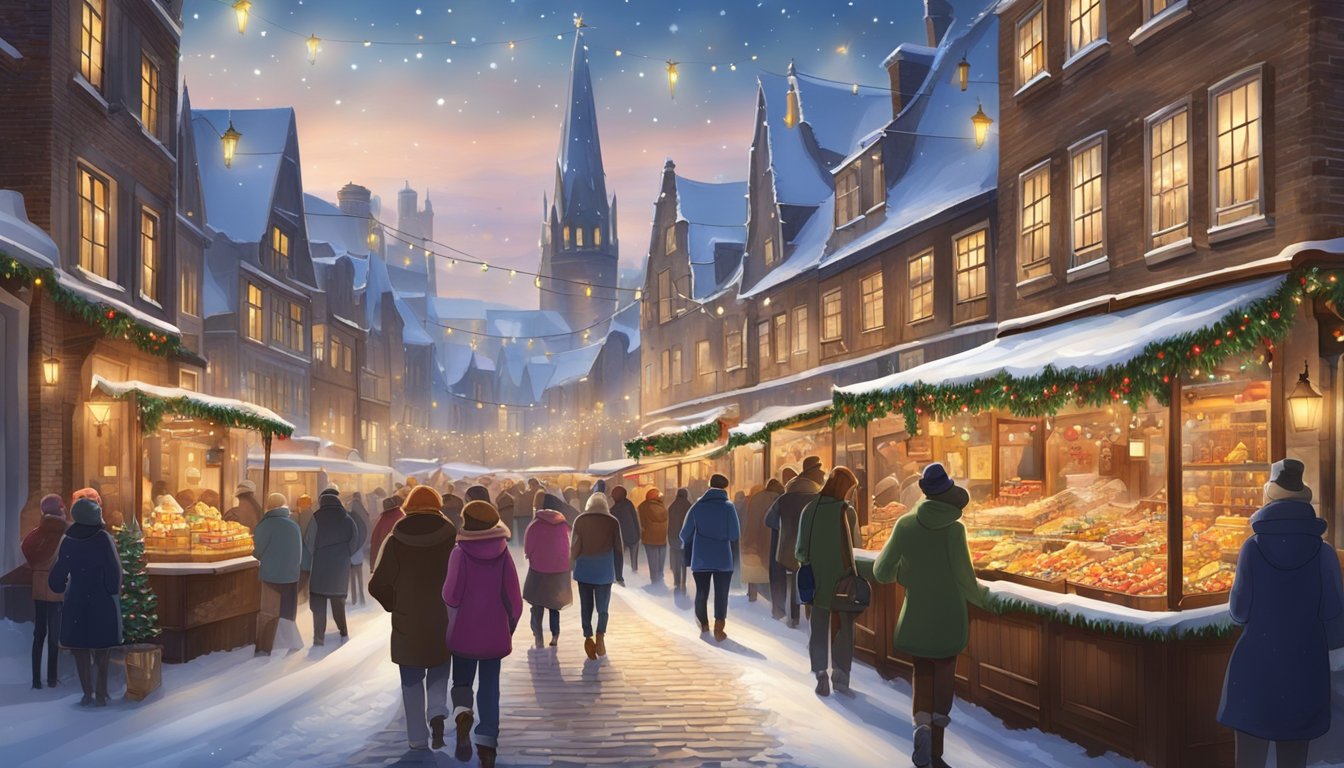
The season in Belgium starts with the feast of Sinterklaas, celebrated on December 6th, though preparations and smaller events begin in late November. Children eagerly await the arrival of Sinterklaas, also known as St. Nicholas, whom legends say travels from Spain to Belgium to deliver presents to well-behaved children. Belgians hold This age-old tradition dearly, and it signals the official start of the Christmas festivities across the country.
Aside from the Sinterklaas celebrations, Belgian households and towns also embrace the typical European Christmas customs, such as setting up a Christmas tree, engaging in family dinners, and attending church services. The culinary aspects of Christmas play a significant role in Belgium, with a range of festive foods and treats reflecting the country’s renowned gastronomy. Throughout the season, community and kinship are central to the Belgian Christmas spirit, making it an enchanting time to experience Belgium’s heartwarming customs and cultural richness.
The History of Christmas in Belgium

Belgium’s Christmas celebrations showcase a rich history soaked in diverse traditions, reflecting its multi-lingual and cultural composition. The festivities pivot around two key figures: Sinterklaas (Saint Nicholas) and, in some parts, Père Noël (Father Christmas).
Sinterklaas, the forerunner to Santa Claus, is a central figure of Belgian Christmas lore. Traditionally celebrated on December 6th, Saint Nicholas’ Day is especially significant for children:
- They leave shoes by the fireplace with carrots and water for Sinterklaas’ horse.
- In return, they hope to receive sweets and gifts from Saint Nicholas.
The figure of Zwarte Piet (Black Pete), historically portrayed as Saint Nicholas’ helper, accompanies him. This character has undergone significant scrutiny and reassessment in recent years to ensure cultural sensitivity.
Advent season marks the onset of Christmas time, leading up to the evening of December 24th, when the main celebration of the Christmas Eve meal occurs. This meal often includes sumptuous dishes with seafood and traditional cakes resembling a yule log.
On December 25th, some families in Wallonia also celebrate with Père Noël, akin to Santa Claus in other Western traditions, bringing gifts to children.
The intertwining of customs from neighbouring countries Germany, France, and the Netherlands further enriches the Belgian Christmas experience, culminating in a festive period that spans the entire month of December until New Year’s Day.
Celebrating Christmas Eve and Christmas Day
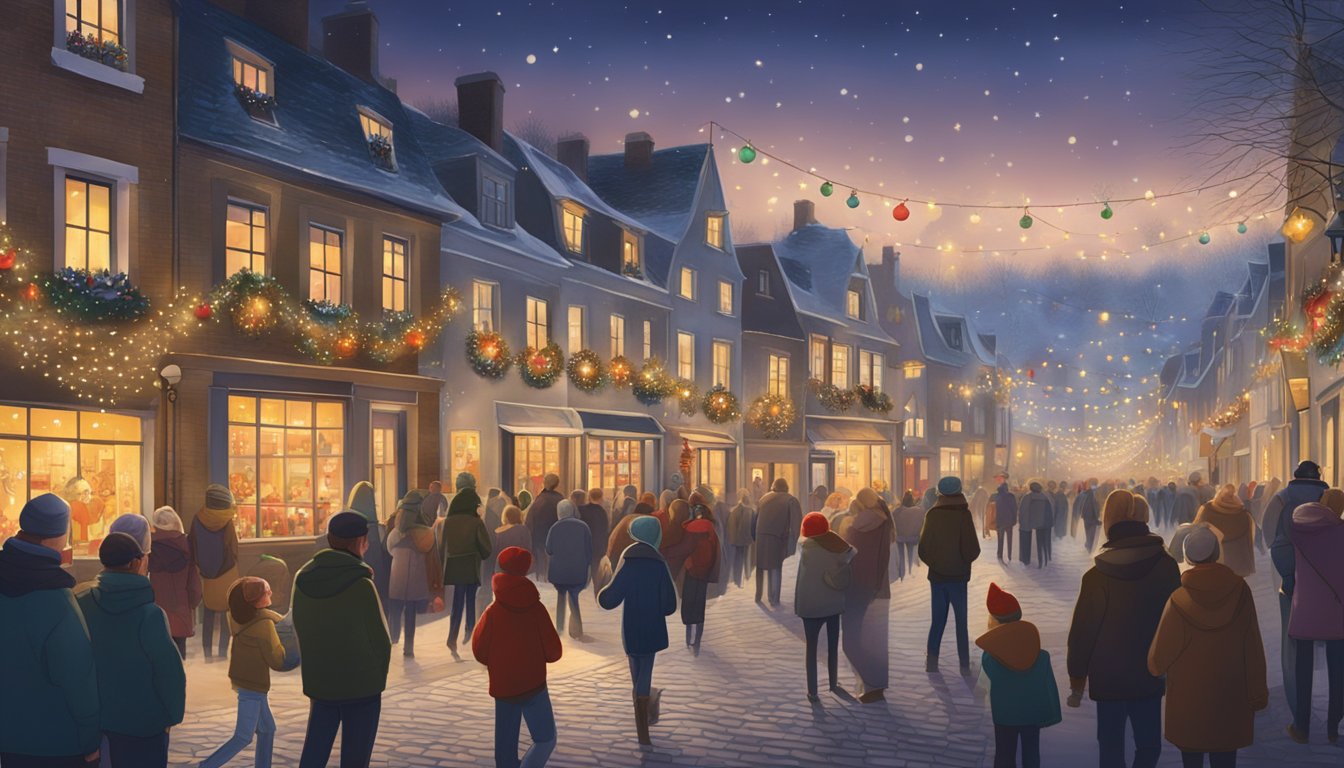
In Belgium, Christmas Eve and Christmas Day are characterized by warm family gatherings, sumptuous dinners, and the observance of religious traditions that have been cherished for generations.
Family Gatherings and Traditions
Families in Belgium place great importance on coming together on Christmas Eve. This is a time for intimacy and unity, where they engage in the ritual of gift exchanges and enjoy the company of loved ones. Homes are often decorated with nativity scenes, symbolizing the birth of Jesus, which forms a central part of the celebrations.
Dinner Customs and Special Dishes
The Belgian Christmas Eve dinner is a lavish affair. The tables are laden with various traditional dishes, including seafood and game. One cannot overlook cougnou or cougnolle, a sweet bread also known as ‘bread of Jesus’, shaped like the baby Jesus and typically enjoyed during this holiday period.
- Starters: Often consist of luxurious items such as smoked salmon or pâté.
- Main Course: Goose, turkey, or rabbit may be served.
- Dessert: A classic is the chocolate Christmas log, which adds a festive end to the meal.
Christmas Mass and Religious Observances
For many Belgians, attending midnight mass on Christmas Eve is a solemn tradition. Churches hold special services to commemorate the nativity, which are usually well-attended, reflecting the country’s religious heritage. Christmas Day is a more reflective day, where many continue to celebrate with family, and often another visit to the church to honour the holiday’s significance.
Cultural Specifics of a Belgian Christmas
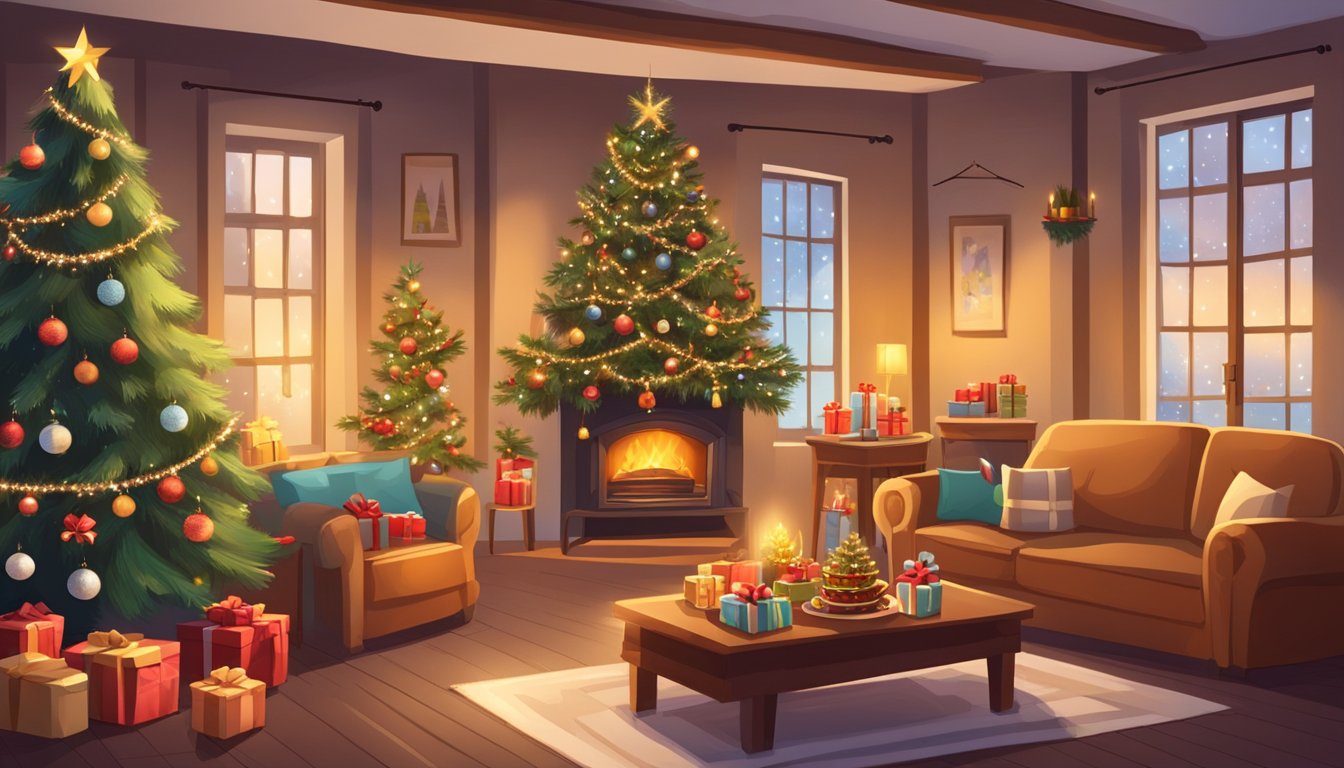
Belgian Christmas celebrations are characterized by rich traditions that vary regionally and are influenced by the multilingual nature of the country. Local customs and culinary delights are crucial in shaping the festive experience.
Languages and Greetings
Belgian Christmas greetings differ depending on the linguistic region. In Flanders, the Dutch-speaking part of Belgium, people wish each other “Vrolijk Kerstfeest”, which translates to “Merry Christmas” in English. The French-speaking region of Wallonia greets the festive season with “Joyeux Noël”; in the German-speaking areas, “Frohe Weihnachten” is the standard holiday salutation.
Regional Variations Across Belgium
Each linguistic region in Belgium has its unique way of celebrating Christmas, reflecting their cultural heritage:
- Flemish Region: Here, the Dutch language and Flemish traditions dictate the Christmas celebrations. Children eagerly anticipate the arrival of “Sinterklaas” on December 6th, setting out their shoes filled with carrots and treats the night before, hoping to find them filled with gifts and sweets like speculoos and chocolate figurines come morning.
- Walloon Region: The French influence is strong in Wallonia, and the night before Christmas is especially significant. A special meal, “le reveillon de Noel”, is prepared, often featuring courses such as seafood, followed by a turkey main course. Christmas Eve gatherings are intimate family affairs celebrated with great enthusiasm.
- German-speaking Community: Although the smallest linguistic communities in Belgium, the German-speaking areas maintain their distinct customs. They share some of the same Christmas characters and customs with their German neighbours, putting a local twist on the festive traditions.
Traditional Belgian Christmas food, including unique chocolates and various beers, is enjoyed throughout the season and is a source of pride in the country’s rich culinary landscape.
Christmas Markets and Festivities
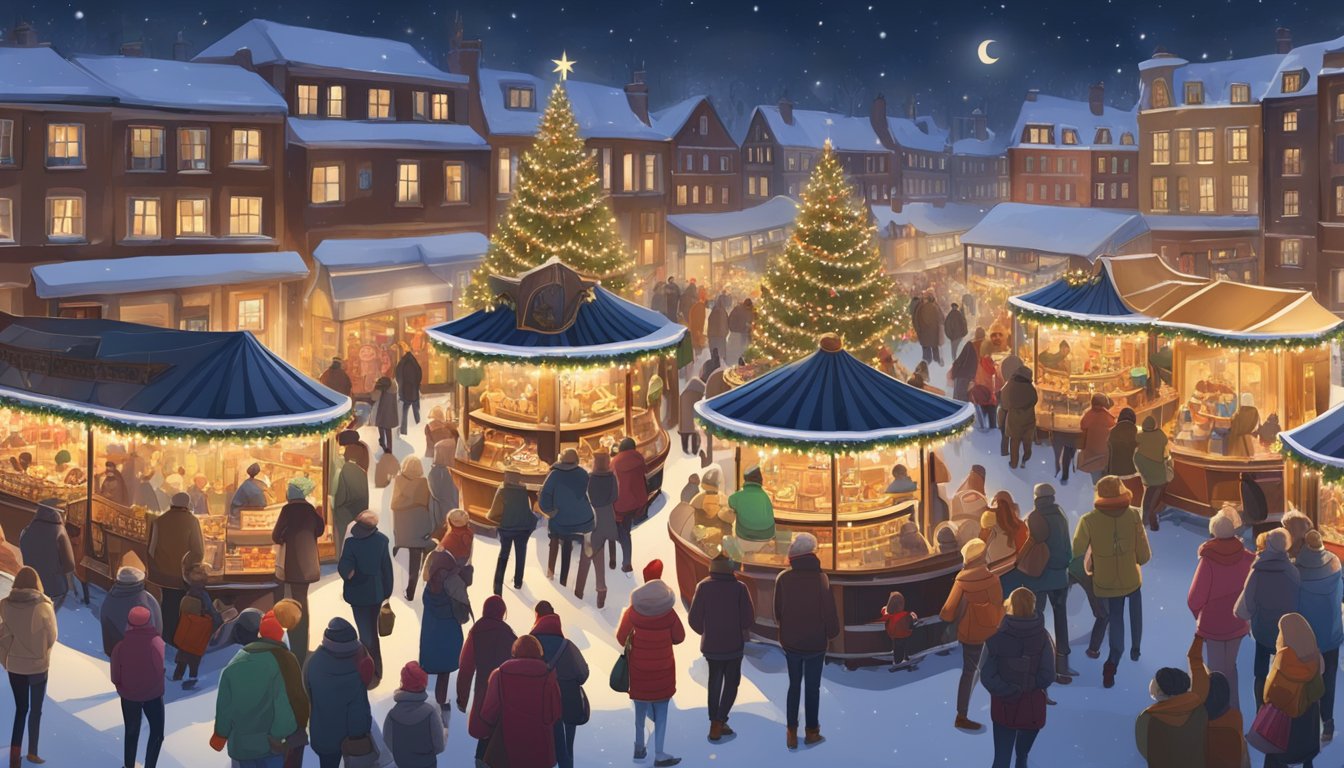
Belgium’s Christmas markets are renowned for their festive atmosphere, where visitors can explore a world of twinkling lights, seasonal treats, and artisanal crafts. From the central squares of major cities to unique attractions in smaller towns, each market offers a distinct holiday experience.
Brussels Winter Wonders
Brussels transforms during the holiday season with its Winter Wonders event, centred around the Grand Place. This market features over 200 wooden chalets selling crafts, food, and warm drinks. The event includes a giant Ferris wheel and a variety of other rides that brighten the winter nights.
Medieval Charm in Bruges and Ghent
In Bruges, the Christmas market is in the Grote Markt, surrounded by historical, medieval buildings, providing an enchanting backdrop. Ghent’s Christmas market also offers a medieval charm and is a hub for holiday festivities, with a focus on local artisan goods and seasonal Belgian specialities.
Antwerp’s Holiday Celebrations
Antwerp invites visitors to experience its Christmas market, which sprawls across several city squares, including the Grote Markt. Emphasizing the joyous spirit, Antwerp’s holiday celebrations include ice skating rinks, many gift ideas from festive wooden chalets, and delicious local treats.
Unique Attractions Across Towns
Smaller towns across Belgium boast unique Christmas markets, often featuring regional products and specialities. These markets may be less extensive than the ones in larger cities. Still, they are rich in local charm and usually less crowded, offering a more intimate holiday shopping and entertainment experience.
Festive Foods and Belgian Delicacies
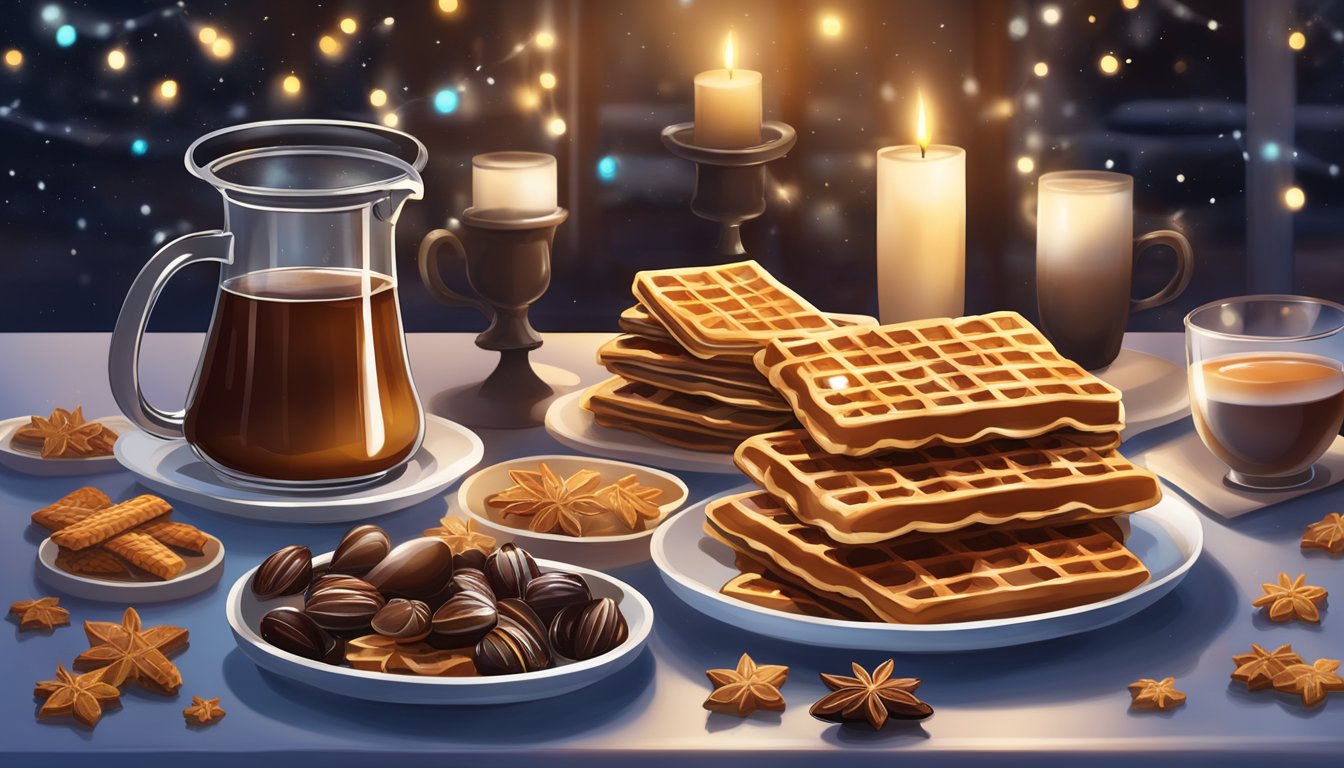
Belgium’s Christmas cuisine captures the festive spirit with an indulgent array of desserts and chocolates, warming beverages, and traditional treats central to the holiday celebrations.
Chocolate and Desserts
Chocolate plays a pivotal role in Belgian Christmas festivities, with artisans crafting intricate figurines and chocolate Christmas logs that are as pleasing to the eye as they are to the palate. The holiday season is also a time for gingerbread and speculoos, a shortcrust biscuit that is often elaborately decorated and flavoured with a unique blend of spices.
- Speculoos: Spiced shortcrust biscuits, typically enjoyed alongside coffee or tea.
- Chocolate Christmas Log: A festive dessert resembling a log made of chocolate sponge cake filled with cream.
Holiday Beverages
Beverages offer warmth and comfort against the winter chill. Mulled wine, known locally as glühwein, and hot chocolate are ubiquitous at Christmas markets, their aromas infusing the air. Indeed, jenever, a juniper-flavoured spirit akin to gin, is another seasonal favourite, often consumed to foster a convivial atmosphere among friends and family.
- Mulled Wine (glühwein): Warm and spiced, a traditional holiday drink for adults.
- Hot Chocolate: Rich and creamy, often homemade, and sometimes served with a splash of liqueur.
Traditional Belgian Christmas Treats
The traditional Belgian Christmas table is laden with various treats that include both savoury and sweet flavours. Seafood and turkey often feature as centrepieces in the holiday meal. Waffles, though enjoyed year-round, have become especially popular, and smoutebollen, deep-fried sweet dumplings are a common sight at festive gatherings.
- Seafood: A staple at Christmas dinners, with dishes like shrimp croquettes gracing the table.
- Turkey: A traditional choice for the main course, served with various side dishes.
- Waffles: Served warm, often with powdered sugar or chocolate sauce.
- Smoutebollen: Sweet dumplings dusted with powdered sugar and typically found at Christmas markets.
Yuletide Decorations and Traditions

Belgian Christmas celebrations are characterized by splendid decorations and unique traditions that blend religious and familial values.
The Belgian Christmas Tree
In Belgium, the Christmas tree is a central symbol of the holiday season. Homes are adorned with beautifully decorated trees that often reach impressive heights. The trees are typically dressed with twinkling lights, glittering baubles, and sparkling tinsel. It is customary for families to gather and decorate the tree together, creating a festive atmosphere within the home.
Home and City Decorations
Throughout Belgium, cities come alive with festive decorations during Christmas. Streets and shops are adorned with lights and wreaths, creating a warm, inviting glow that beckons visitors and locals alike.
- Homes are decorated with care, often featuring a cosy fireplace where children place their shoes, hoping Santa Claus will fill them with gifts. In keeping with tradition, they may also leave a book for Santa to sign and a carrot for Santa’s donkey.
- Public squares in the cities transform into vibrant Christmas markets, with vendors selling a variety of Christmas decorations, amongst which unique Belgian Christmas chocolates and intricate nativity scenes stand out.
The interplay of home and city decorations in Belgium brings life to the festive season, making it a culturally rich and visually enchanting time of the year.
Belgian Christmas for Youngsters

In Belgium, Christmas is not solely a December 25th celebration, especially for the children. The festive period begins earlier with the eagerly awaited arrival of Sinterklaas, also known as Saint Nicholas, who is at the heart of Belgian Christmas traditions for youngsters.
Arrival of Sinterklaas: When Sinterklaas visits, children anticipate December 6th, St. Nicholas’ Day. According to tradition, this beloved figure travels from Spain by boat, arriving with his helper, Zwarte Piet.
- Early December Gifts:
- On the eve of St. Nicholas’ Day, children place their shoes by the fireplace or the door, along with carrots or hay for Sinterklaas’s horse.
- In return, if the children have been well-behaved, Sinterklaas leaves behind presents and treats, such as speculoos (spiced cookies) or chocolate figurines.
Santa Claus: As the 25th of December draws closer, Belgian kids also look forward to a visit from Santa Claus, who brings another round of gift-giving, complementing the treats from Sinterklaas.
Cultural Nuance: Zwarte Piet has been debated due to racial connotations. Some regions are evolving this tradition for a more inclusive approach.
Festive Activities: Belgian children enjoy various other festivities, including Christmas Markets, Puppet Shows and Carrolling.
Through these customs, Belgian Christmas for youngsters is a vibrant blend of folklore, family time, and, of course, the joy of receiving gifts from the two iconic figures of the season: Sinterklaas and Santa Claus.
Frequently Asked Questions

What are typical Christmas traditions in Belgium?
Typically, Belgium’s Christmas traditions are rich and vary by region. They include attending midnight mass, exchanging gifts, and hosting family gatherings. The celebration of Sinterklaas on December 6th is particularly significant, marking the beginning of the festive season.
What kind of food is traditionally eaten during Christmas in Belgium?
Traditional Christmas foods in Belgium include roasted meats, such as turkey or goose, and a variety of desserts like ‘kerststronk’, a chocolate yule log. They also enjoy ‘speculaas’, a spiced shortcrust biscuit commonly associated with the festivities.
Can you share some interesting historical facts about Christmas in Belgium?
Historically, Belgium embraced Christmas as its most treasured holiday due to its predominantly Christian society. Over the years, while religious connotations have decreased, the festive spirit remains strong, with the celebration of Christmas rooted deeply in Belgian culture.
What are the highlights of Belgium’s Christmas markets?
Belgium’s Christmas markets highlight many vendors selling handcrafted goods, seasonal treats, and warm drinks. They are often accompanied by ice skating rinks and fairground attractions, creating a festive atmosphere in towns and cities.
How do Belgians typically decorate for Christmas?
Belgians typically decorate for Christmas with twinkling lights, nativity scenes, and Christmas trees adorned with ornaments. Towns are also festively decorated, often showcasing impressive light displays and decorations in public spaces.
Who is the Santa Claus figure in Belgian Christmas celebrations?
In Belgian Christmas celebrations, the Santa Claus figure is known as Sinterklaas or Saint Nicholas, who is said to visit on December 6th. He is traditionally depicted as a bishop, travelling from Spain to deliver presents to children, accompanied by his helper, Zwarte Piet.
